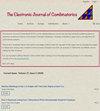极值广义六边形的组合表征
IF 0.7
4区 数学
Q2 MATHEMATICS
引用次数: 1
摘要
当$t$达到最大可能值$s^{e_d}$时,当$t$达到最大可能值$s^{e_d}$时,称为$2d$- $ $(s,t)$,其中$e_2=e_4=2$和$e_3=3$。对于阶$(s,t)$的有限广义$2d$-gon求极值的充分必要组合条件的问题,迄今为止只解决了广义四边形的问题。本文得到了广义六边形的一个解。我们还得到了极值正则近六边形的相关组合表征。本文章由计算机程序翻译,如有差异,请以英文原文为准。
A Combinatorial Characterization of Extremal Generalized Hexagons
A finite generalized $2d$-gon of order $(s,t)$ with $d \in \{ 2,3,4 \}$ and $s \not= 1$ is called extremal if $t$ attains its maximal possible value $s^{e_d}$, where $e_2=e_4=2$ and $e_3=3$. The problem of finding combinatorial conditions that are both necessary and sufficient for a finite generalized $2d$-gon of order $(s,t)$ to be extremal has so far only be solved for the generalized quadrangles. In this paper, we obtain a solution for the generalized hexagons. We also obtain a related combinatorial characterization for extremal regular near hexagons.
求助全文
通过发布文献求助,成功后即可免费获取论文全文。
去求助
来源期刊
CiteScore
1.30
自引率
14.30%
发文量
212
审稿时长
3-6 weeks
期刊介绍:
The Electronic Journal of Combinatorics (E-JC) is a fully-refereed electronic journal with very high standards, publishing papers of substantial content and interest in all branches of discrete mathematics, including combinatorics, graph theory, and algorithms for combinatorial problems.

 求助内容:
求助内容: 应助结果提醒方式:
应助结果提醒方式:


